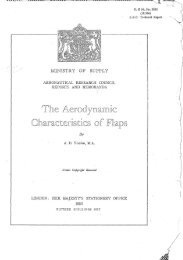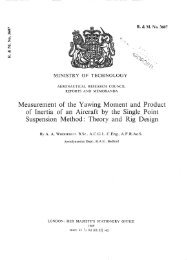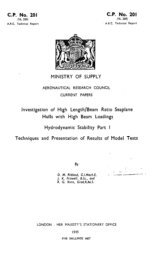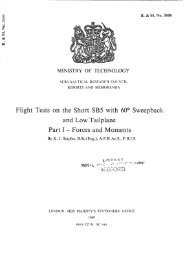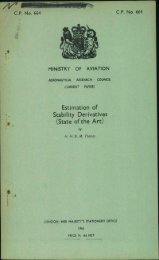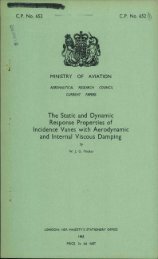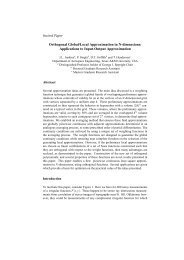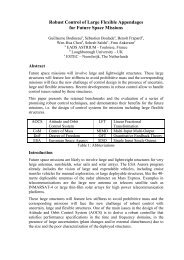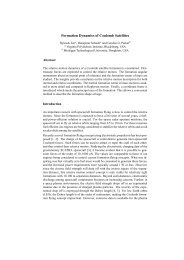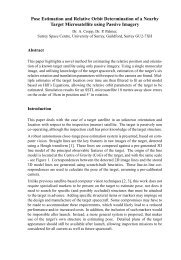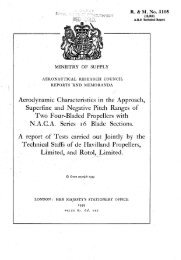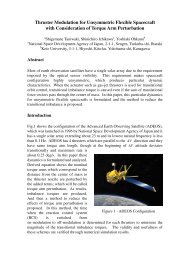A Survey of Unsteady Hypersonic Flow Problems
A Survey of Unsteady Hypersonic Flow Problems
A Survey of Unsteady Hypersonic Flow Problems
You also want an ePaper? Increase the reach of your titles
YUMPU automatically turns print PDFs into web optimized ePapers that Google loves.
-44-<br />
is to reduce further the range <strong>of</strong> values <strong>of</strong> K for which divergence occurs, but<br />
to increase the altitude at which divergence starts when It does occur. Fig. 34<br />
shows that, as in the non-iifting case, K = 0 does not show serious divergence,<br />
but K = +2 does.<br />
Confirmation <strong>of</strong> the qualitative valltity <strong>of</strong> the simplified analyses <strong>of</strong><br />
re-entry which have been discussed is provided in Ref. 53, where the results are<br />
presented <strong>of</strong> a 6-degree <strong>of</strong> freedom numerical analysis, using experimentally<br />
determined aerodynamic forces, <strong>of</strong> the re-entry motion <strong>of</strong> a blunt uncontrolled<br />
vehxle. This analysis shows; in particular,-that provided<br />
<strong>of</strong> the body IS positive, the motion converges even for<br />
fk, + cm&).<br />
3.1.3 The effect <strong>of</strong> aerodynamic non-linearlties<br />
the lift-curve slope<br />
zero value <strong>of</strong><br />
In Ref. 51, Kistler and Capalongan give the results <strong>of</strong> stubes, using<br />
analogue computers, in which they considered the effects <strong>of</strong> aerodynamic<br />
non-linearitles on the longitudinal dynamx motions <strong>of</strong> hypervelocity, highaltitude<br />
vehicles. They found that reasonable accuracies could be obtained<br />
using linear aerodynamics if the coeffxients were determined at the trim point<br />
<strong>of</strong> the vehlole, and provided the perturbaiions were small. For large perturbations<br />
accuracies began to drop rapdly. The study included level flight and shallow<br />
re-entry conditions and one <strong>of</strong> the conclusions <strong>of</strong> the report was that artificial<br />
damping <strong>of</strong> the vehicles would be necessary, and thx m&t well overshadow any<br />
non-linear aerodynamic damping characteristics.<br />
Laitone and Coakley, in Ref. 50, examine the effect <strong>of</strong> aerodynamic<br />
non-linearities on the pitching oscillations <strong>of</strong> a vehxle flying in a re-entry<br />
traJect0x-y. The results do not affect the ooncluslons that have been drawn<br />
about small amplitude motions, but they show that a steady llml'c cycle oscillation<br />
can exist and that conditions sre possible III whxh osodlatlons will grow If<br />
the initial disturbance exceeds a certain amplitude.<br />
3.2 The Lateral Behaviour <strong>of</strong> the <strong>Hypersonic</strong> Vehicle<br />
In Ref. 52 Nonweiler has also examined, qualitatively, the lateral<br />
dynamic behaviour <strong>of</strong> a hypersonic vehxcle. The analysis is carried out in the<br />
same way as for the longitudinal behavlour: the approxxnate roots for the<br />
stability equation are found under the assumption that terms involving the<br />
relative density, p, are large. The roots show the usual modes: normally,<br />
two non-oscillatory modes and one oscillatory, the 'dutch roll'. An examination<br />
<strong>of</strong> the factors governing the modes shows that it should not be difficult to<br />
ensure convergence <strong>of</strong> the non-oscillatory modes and damping <strong>of</strong> the dutch roll<br />
even for slender bodies at high incidences. But the period <strong>of</strong> the lateral<br />
oscillation is likely to be rather shorter than that <strong>of</strong> the pitching oscillation<br />
for slender bodies at high incidence - typxally 3 seconds for a value <strong>of</strong> KL<br />
<strong>of</strong> unity, but since such bodies are not likely to be operating at large incdences<br />
for low values <strong>of</strong> KL at low altitude, the maximum values <strong>of</strong> frequency parameter<br />
will probably remain <strong>of</strong> the same order as those for the longitudinal pitching<br />
oscillation.<br />
The longitudinal behaviour <strong>of</strong> a hypersonic vehicle flying a ?-e-entry<br />
path has been found to be not essentially different from that <strong>of</strong> the same vehicle<br />
in level flight and it is reasonable to suppose that the same result would be<br />
fauna for the lateral behaviour. The rate <strong>of</strong> decay <strong>of</strong> the lateral OsCilhtiOn<br />
will/



